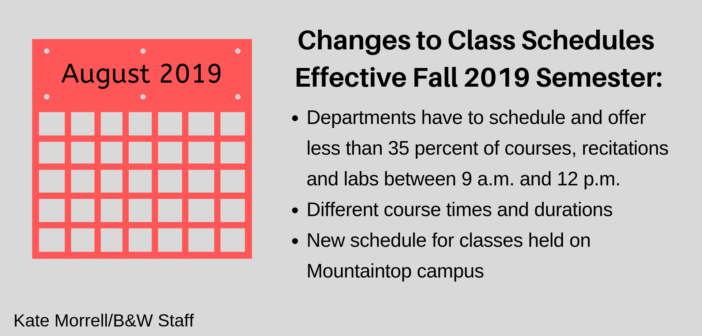Editor’s Note: The Office of the Provost has since notified students of the upcoming class schedule changes in an email to the campus community on Jan. 29.
A memo sent out by the Office of the Provost to university faculty on Jan. 4 outlined significant modifications to the structure of class schedules. The changes are set to be implemented in the fall 2019 semester.
The office of Registration and Academic Services will mandate that each department schedule no more than 35 percent of course sections between the “prime time” hours of 9 a.m. and noon. Additionally, the memo states that a department cannot schedule more than 35 percent of “standalone labs or course-based recitations and labs, on a single day of the week.” No more than half of a department’s courses can follow the same daily pattern, as well.
A new schedule of course times and slots will also be coming.
The new daily schedule will begin at 7:55 a.m. and conclude at 9:55 p.m. All course periods will be 75 minutes in length, with 10 minutes between class times. Lab periods scheduled for 170 minutes will be cut to 160 minutes in the new schedule. Instructors who still prefer a format of three 50-minute courses per week can simply dismiss students after 50 minutes.
The memo states that, “per current practice, courses that are primarily developed for undergraduate enrollment (e.g., numbered 399 or lower) should not be scheduled between 4:15 and 7:05 p.m.”
A revised schedule for Mountaintop classes will also go in effect, in order to offset the difficulty in transporting to and from Asa Packer campus. This schedule will run from 8:25 a.m. to 3:20 p.m. in 75-minute intervals with 10 minutes between courses.
The process and reasoning of the changes
The Office of the Provost said in its memo that a special committee created in spring 2018 reviewed the university’s scheduling practices. The new aforementioned changes are as a result of the committee’s findings and a final 30-page report delivered to the provost.
Steven Wilson, the assistant provost for Academic Affairs and Registrar, said he expects an official announcement will come from the provost in the next week or two to inform students of the changes. He said it was important to inform departments immediately because they will start planning next semester’s schedule over the following six weeks.
Wilson said about a dozen people were appointed to the committee from various constituencies and that everybody was represented from across disciplines. He noted that student representation was present as well, and that the student representative would report the committee’s progress back to Student Senate and would subsequently bring that group’s input back to the committee.
Kathy Iovine, the vice chair of the Faculty Senate and a professor in biological sciences, however, said she wished her group could have been more involved in the process. She said because the appointed committee started discussions before Faculty Senate formally existed, most of the work was already completed before they were aware of the upcoming changes.
“We learned about it in November and were given an opportunity to review the committee’s report and give input and ask some questions… but we didn’t have a lot of say,” Iovine said.
She said she hopes that now, the Faculty Senate will have a say throughout such a process, and not just at the end. Still, she said she supports the changes because “something had to happen so that not all classes are bunched up in the same time period” with “overlapping times.”
The memo cited several reasons for these changes, including departmental requests for class spaces that exceeded the amount of space available during “prime time.” Also, the current schedule’s variations in start and stop times have led to “an inefficient use of space” and “may also limit student options and even delay their progress.” Wilson said that the committee also looked at “aspirational institutions” for ideas on how to improve.
The Office of the Provost also said in the memo that as Lehigh’s enrollment grows, coupled with renovations projects to academic buildings, they expected scheduling challenges to worsen and thus felt it necessary to implement these changes next semester.
Wilson said adding another academic building to accommodate more students isn’t necessary but acknowledged that the university will have to look at it again if in a few years scheduling and space are still tight.
Wilson said he feels his office has been proactive in responding to emerging student population growth.
“Without speaking for the provost, I’ve been in my role with the registrar for about two years now, and from the beginning we’ve been talking about possible changes we needed to make because of Path to Prominence,” Wilson said. “In that sense, we’ve been thinking about it for some time. I’ve been making suggestions to faculty and departments to change their habits. Now we are trying to get out ahead of what we think will happen in the next couple years… we really need to have some actual guidelines for people to follow so they know what the expectations are.”
Still, though, Wilson refuted the idea that the university’s plans for growth in the student body are unsustainable.
Instead, he focused on the facilities that the university has to offer now. He said the new model is a better use of classroom space and allows less time of classrooms sitting empty.
“It’s not that we’re running out of space or teaching facilities, we’re just trying to lay out some rules that encourage the departments to lay out their schedule and kick start people’s habits changing,” Wilson said. “A little more thought needs to go in to how your schedule is balanced and how you’re using that space.”
Cameron Wesson, the interim dean of the College of Arts and Sciences, agreed that the influx in students to the university has not “reached that critical point yet” of being unsustainable but did say “it’s a delicate balancing act” in regard to having the timing work out between an increase in student enrollment, building renovations that are underway and living and learning opportunities that may require expansion.
Wilson said the crux of the issue has been compounded by the university’s plans to expand.
“The real issue is that everybody wants to teach and go to class between 9 a.m. and noon, but it’s just not sustainable — especially when we add 1,000 new students,” Wilson said.
The impacts
Wilson noted that the current average across the university for a department’s courses held in prime time is roughly 45 percent, so asking departments to bump that number down to 35 percent will require a little more thought in the planning process — especially after the committee’s study of how larger schools balance scheduling.
He said the overloading of scheduled classes during prime time might be a self-fulfilling mechanism, in which “the departments presume that students won’t take early morning or late afternoon classes, and so they don’t schedule them that way,” which causes students to sign up for the classes they need during prime time.
Wesson said that although change is always difficult, he believes these changes will prove beneficial in the long run, while also cautioning for “unforeseen complications.” He said that with fewer classes in prime time and more classes scheduled throughout the week, students can take classes outside of their major or to study another major.
“Lehigh students are notorious for not wanting to take early morning classes and not wanting to take classes on Friday, and faculty has tried to accommodate by teaching two-day courses,” Wesson said. “The problem has become as the number of those courses being offered has increased, they have overlapped with three-day 50 minute classes. You are knocked out of two class periods by taking 75 minute classes.”
Under the current schedule, a student signed up for a 10:10 to 11 a.m. class is automatically locked out of taking both a 9:20 to 10:35 a.m. course and a 10:45 a.m. to noon course. The new strategy would prevent this time conflict.
Wesson said he believes this reduction in time conflicts is critical. He said many students have had trouble fitting a class that is necessary to graduate or earn a major degree into their schedule when another important class overlaps, and leads to administrators working with students to find a course substitution or another way to complete the degree without taking the class itself that is in conflict. This process is complicated and less than ideal for himself and the students, he said.
Wesson said the impact for students under this new system would be positive.
“I think that quality of instruction probably remains the same or increases from a student perspective because you will have an easier time getting the classes and times you want when you want them,” Wesson said. “Instead of taking courses in which you have minimal interest, you will be able to learn in these courses more vigorously, as students usually do well in those courses in which they have an abiding interest in.”
Wilson said other ideas were considered in the committee, such as changing the daily format to have Monday/Thursday and Tuesday/Friday classes, and leave Wednesday open for labs and recitations. The goal behind this concept would be to evenly disperse courses and workload throughout the week.
Ultimately, the committee thought it was too “radical” and “different” on top of their other changes. Wilson said, however, that for pedagogical reasons individual departments are not prohibited from instituting such a schedule.
Wesson emphasized the good that will be done by adding more early-morning classes. He said showing up early to a job is a “prerequisite for most employers” and said it will promote self-discipline among students.
There are some concerns, however, and Wesson expects more are on the horizon.
He said that a discussion is needed surrounding 4 o’clock exams, especially since the new schedule will run until 4:15 p.m. Student Senate has already been in discussions about whether to keep them or get rid of them, Wesson said, and the memo from the Office of the Provost announced they will be preparing a “modified” 4 o’clock exam schedule for next fall and is encouraging in-class exams to reduce the number of days of 4 o’clocks.
Student Senate did not return a request for comment.
Wesson also said under the current scheduling system, a few departments might be late in getting their course schedules built and approved for the following semester. He said he expects an increase in the number of departments needing time to adjust this time around, possibly delaying students in attempting to construct their schedules for next fall, but that this would be a “one time” problem as departments adapt to the new system.
Iovine noted the biggest concern among her department is attempting to schedule lab sections under the new guidelines.
“We start working on the class schedule for the fall in January or February, so we’re going to have to rethink the way that we organize our classes since… there are fewer (overall) slots per day,” Iovine said. “The biggest impact will be the lab classes that we run, as we have to run enough sections with the smaller number of slots.”
Though she doesn’t believe quality of instruction would be compromised under the new rules, she said class sizes could be forced to increase with fewer time periods during the regular day to hold class.
Wilson said the reaction from faculty has been fairly mellow due to winter break, noting a few questions since “not everything is spelled out” in the memo, but expects more questions in the coming weeks. He reiterated that departments will still have “an awful lot of flexibility” in developing their schedules for next fall.
When asked how the university plans to enforce these new changes and what the protocol is if a department chose not to follow a particular guideline, Wilson said he could not comment on such internal processes, but said in an email that “the office of RAS will be working actively with departments to implement their proposed schedules.”
Wesson outlined what he hopes the campus community will gain from these changes.
“I have hopes that this new model will result in fewer student enrollment issues and fewer transportation issues between Asa Packer campus and Mountaintop,” Wesson said. “Hopefully, it will make things more predictable, easier to schedule, and easier to go back and forth to Mountaintop. Happier students make for a happier campus culture.”






Comment policy
Comments posted to The Brown and White website are reviewed by a moderator before being approved. Incendiary speech or harassing language, including comments targeted at individuals, may be deemed unacceptable and not published. Spam and other soliciting will also be declined.
The Brown and White also reserves the right to not publish entirely anonymous comments.
2 Comments
Why not consider the class length at 70 minutes rather than the proposed 75…? This would allow for a compression of the day to between the hours of 8:10 a.m. (first class start) to 4:00 p.m. (last class end, plus the 10 minute buffer). The slightly lesser length of the typical class all would probably enjoy and it would allow for a later and more reasonable start to the day. Additionally, the 4 o’clock exam scheduling would be able to exist unchanged.
When I attended, I never much liked starting prior to 8:00 a.m…. but actually did enjoy how the 4 o’clock exams would fit into the daily routine, allowing dinner to comfortably follow.
Actually, under this (proposed) system, there would be no buffer at 4:00 p.m. … The final class would end at 4:00 p.m. precisely. However, if I recall accurately, there was never any ’10 minute buffer’ prior to the 4 o’clocks, viz. all classes would, and presumably still do now, end at 4 p.m. exactly. I presume it is/was a 50 minute exam therefore …?
The Mon. – Fri. classes, with the 10 minute breaks, would therefore be:
1. 8:10 a.m. – 9:20 a.m.
2. 9:30 a.m. – 10:40 a.m.
3. 10:50 a.m. – 12:00 noon
4. 12:10 p.m. – 1:20 p.m.
5. 1:30 p.m. – 2:40 p.m.
6. 2:50 p.m. – 4:00 p.m.